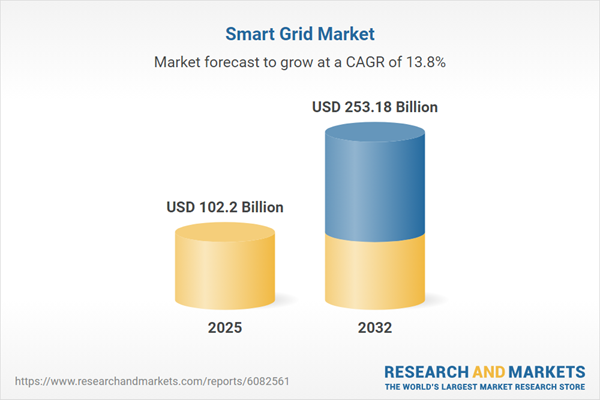Speak directly to the analyst to clarify any post sales queries you may have.
The global smart grid market is undergoing a rapid transformation as power utilities, technology providers, and regulators embrace digitalization and sustainability. Sector modernization is driven by advanced digital technologies, automation, and integration of distributed and renewable energy sources—placing senior decision-makers at the core of future energy strategies.
Market Snapshot: Smart Grid Market Size and Growth
The Smart Grid Market grew from USD 89.87 billion in 2024 to USD 102.20 billion in 2025. It is expected to continue growing at a CAGR of 13.82%, reaching USD 253.18 billion by 2032. This robust growth trajectory reflects the increasing demand for resilient, efficient, and digitally connected power infrastructures across global regions. Key contributors include rising reliability demands, grid automation, and the integration of distributed energy assets.
Scope & Segmentation
- Component Types: Communication modules (wired, wireless), controllers and sensors (intelligent electronic devices, remote terminal units), distribution automation devices (automated reclosing, feeder automation), smart meters (advanced, basic), transmission automation devices (control switchgear, protective relays)
- Offering Models: Hardware (communication, control, meter hardware), services (consulting, integration, support and maintenance), software (distribution management, energy management, outage management, SCADA—electrical and telecom)
- Core Application Sectors: Asset management (inventory management, predictive maintenance), demand response management (real time and time of use pricing), electric vehicle charging infrastructure (AC and DC fast charging), outage management (fault detection, restoration systems), renewable integration (solar, wind), virtual power plants (aggregation, optimization)
- End Users: Commercial and industrial (commercial buildings, industrial plants), residential (multi family, single family), utilities (distribution, transmission utilities)
- Technology Enablers: Artificial intelligence (deep learning, machine learning), big data analytics (descriptive, predictive, prescriptive analytics), cloud (private and public), cybersecurity (endpoint and network security), IoT (device and network IoT)
- Regional Breakdown: Americas (United States, Canada, Mexico, Brazil, Argentina, Chile, Colombia, Peru), Europe, Middle East & Africa (United Kingdom, Germany, France, Russia, Italy, Spain, Netherlands, Sweden, Poland, Switzerland, UAE, Saudi Arabia, Qatar, Turkey, Israel, South Africa, Nigeria, Egypt, Kenya), Asia-Pacific (China, India, Japan, Australia, South Korea, Indonesia, Thailand, Malaysia, Singapore, Taiwan)
- Leading Companies: ABB Ltd, Siemens AG, Schneider Electric SE, General Electric Company, Itron, Inc., Landis+Gyr AG, Cisco Systems, Inc., Honeywell International Inc., Eaton Corporation plc, Hitachi, Ltd
Key Takeaways for Decision-Makers
- Digitalization and grid automation have become central pillars, enabling real-time monitoring, control, and predictive analytics across evolving power distribution networks.
- Advanced integration of renewable generation and distributed energy resources is reshaping system architecture, requiring sophisticated energy management and asset optimization solutions.
- Emerging technologies such as artificial intelligence, IoT, and big data analytics increasingly underpin operational decision-making, driving efficiency and system resilience.
- Regional market differences reflect unique regulatory frameworks and investment patterns, with the Americas accelerating infrastructure upgrades, EMEA focusing on decarbonization, and Asia-Pacific scaling electrification programs.
- Collaborative initiatives—spanning partnerships across IT, telecom, and energy sectors—are enhancing solution interoperability and supporting new service and as-a-service models.
Tariff Impact: Navigating External Market Pressures
The United States’ 2025 tariff measures on key smart grid components have increased pressure on global supply chains and vendor procurement strategies. Manufacturers are adapting by diversifying their sourcing and partnering with domestic suppliers to mitigate cost volatility. This shift is prompting renewed innovation and the strengthening of local supply ecosystems, despite near-term impacts on project timelines and capital expenditure.
Methodology & Data Sources
Research findings are based on a robust multimethod approach. Primary data was collected through interviews with industry executives and regulatory experts. Secondary sources include analysis of industry publications, corporate financial statements, and peer-reviewed literature. Data was rigorously validated by cross-referencing bottom-up and top-down assessment and reviewing expert feedback.
Why This Report Matters for Senior Leaders
- Gives actionable insights for aligning digital, regulatory, and sustainability strategies in a rapidly evolving marketplace.
- Allows benchmarking against global and regional leaders to prioritize investment and partnership decisions.
- Identifies urgent threats and emerging opportunities related to tariff environments, distributed energy, and automation trends.
Conclusion
The smart grid market presents compelling opportunities for those positioned to balance digital innovation with operational resilience. This report equips decision-makers with the strategic clarity necessary to lead modernization efforts and capture new value from advanced grid technologies.
Table of Contents
3. Executive Summary
4. Market Overview
7. Cumulative Impact of Artificial Intelligence 2025
Companies Mentioned
The companies profiled in this Smart Grid market report include:- ABB Ltd
- Siemens AG
- Schneider Electric SE
- General Electric Company
- Itron, Inc.
- Landis+Gyr AG
- Cisco Systems, Inc.
- Honeywell International Inc.
- Eaton Corporation plc
- Hitachi, Ltd
Table Information
| Report Attribute | Details |
|---|---|
| No. of Pages | 189 |
| Published | November 2025 |
| Forecast Period | 2025 - 2032 |
| Estimated Market Value ( USD | $ 102.2 Billion |
| Forecasted Market Value ( USD | $ 253.18 Billion |
| Compound Annual Growth Rate | 13.8% |
| Regions Covered | Global |
| No. of Companies Mentioned | 11 |









